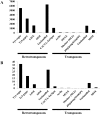Analysis of transposable elements in the genome of Asparagus officinalis from high coverage sequence data
- PMID: 24810432
- PMCID: PMC4014616
- DOI: 10.1371/journal.pone.0097189
Analysis of transposable elements in the genome of Asparagus officinalis from high coverage sequence data
Abstract
Asparagus officinalis is an economically and nutritionally important vegetable crop that is widely cultivated and is used as a model dioecious species to study plant sex determination and sex chromosome evolution. To improve our understanding of its genome composition, especially with respect to transposable elements (TEs), which make up the majority of the genome, we performed Illumina HiSeq2000 sequencing of both male and female asparagus genomes followed by bioinformatics analysis. We generated 17 Gb of sequence (12×coverage) and assembled them into 163,406 scaffolds with a total cumulated length of 400 Mbp, which represent about 30% of asparagus genome. Overall, TEs masked about 53% of the A. officinalis assembly. Majority of the identified TEs belonged to LTR retrotransposons, which constitute about 28% of genomic DNA, with Ty1/copia elements being more diverse and accumulated to higher copy numbers than Ty3/gypsy. Compared with LTR retrotransposons, non-LTR retrotransposons and DNA transposons were relatively rare. In addition, comparison of the abundance of the TE groups between male and female genomes showed that the overall TE composition was highly similar, with only slight differences in the abundance of several TE groups, which is consistent with the relatively recent origin of asparagus sex chromosomes. This study greatly improves our knowledge of the repetitive sequence construction of asparagus, which facilitates the identification of TEs responsible for the early evolution of plant sex chromosomes and is helpful for further studies on this dioecious plant.
Conflict of interest statement
Figures




Similar articles
-
Identification, characterization and distribution of transposable elements in the flax (Linum usitatissimum L.) genome.BMC Genomics. 2012 Nov 21;13:644. doi: 10.1186/1471-2164-13-644. BMC Genomics. 2012. PMID: 23171245 Free PMC article.
-
Young, intact and nested retrotransposons are abundant in the onion and asparagus genomes.Ann Bot. 2013 Sep;112(5):881-9. doi: 10.1093/aob/mct155. Epub 2013 Jul 25. Ann Bot. 2013. PMID: 23887091 Free PMC article.
-
The landscape of transposable elements and satellite DNAs in the genome of a dioecious plant spinach (Spinacia oleracea L.).Mob DNA. 2019 Jan 18;10:3. doi: 10.1186/s13100-019-0147-6. eCollection 2019. Mob DNA. 2019. PMID: 30675191 Free PMC article.
-
Transposable elements in mosquitoes.Cytogenet Genome Res. 2005;110(1-4):500-9. doi: 10.1159/000084983. Cytogenet Genome Res. 2005. PMID: 16093703 Review.
-
Mammalian transposable elements and their impacts on genome evolution.Chromosome Res. 2018 Mar;26(1-2):25-43. doi: 10.1007/s10577-017-9570-z. Epub 2018 Feb 1. Chromosome Res. 2018. PMID: 29392473 Free PMC article. Review.
Cited by
-
Genetic Transformation and Genomic Resources for Next-Generation Precise Genome Engineering in Vegetable Crops.Front Plant Sci. 2017 Feb 22;8:241. doi: 10.3389/fpls.2017.00241. eCollection 2017. Front Plant Sci. 2017. PMID: 28275380 Free PMC article. Review.
-
Repetitive sequences and epigenetic modification: inseparable partners play important roles in the evolution of plant sex chromosomes.Planta. 2016 May;243(5):1083-95. doi: 10.1007/s00425-016-2485-7. Epub 2016 Feb 26. Planta. 2016. PMID: 26919983 Review.
-
Fundamentally different repetitive element composition of sex chromosomes in Rumex acetosa.Ann Bot. 2021 Jan 1;127(1):33-47. doi: 10.1093/aob/mcaa160. Ann Bot. 2021. PMID: 32902599 Free PMC article.
-
Green and White Asparagus (Asparagus officinalis): A Source of Developmental, Chemical and Urinary Intrigue.Metabolites. 2019 Dec 25;10(1):17. doi: 10.3390/metabo10010017. Metabolites. 2019. PMID: 31881716 Free PMC article. Review.
-
Chromosome-level genome assembly, annotation and evolutionary analysis of the ornamental plant Asparagus setaceus.Hortic Res. 2020 Apr 1;7(1):48. doi: 10.1038/s41438-020-0271-y. eCollection 2020. Hortic Res. 2020. PMID: 32257234 Free PMC article.
References
Publication types
MeSH terms
Substances
LinkOut - more resources
Full Text Sources
Other Literature Sources
Miscellaneous

